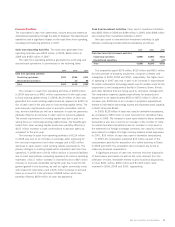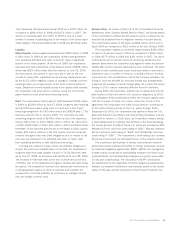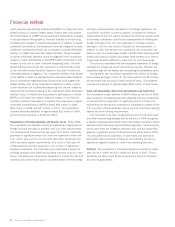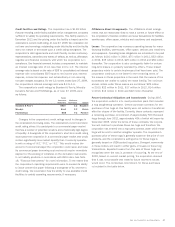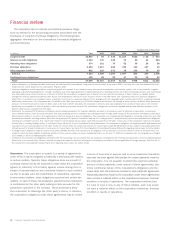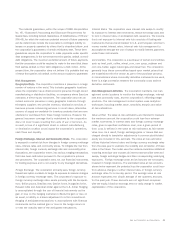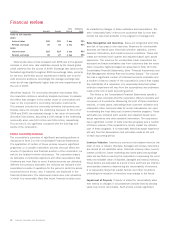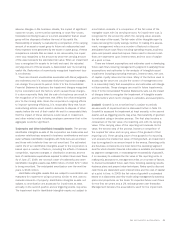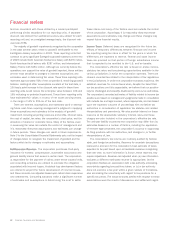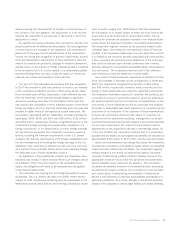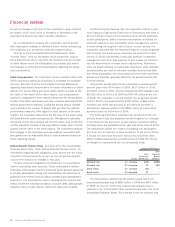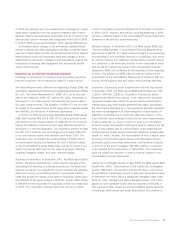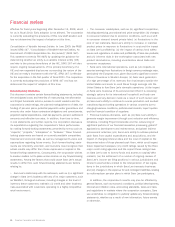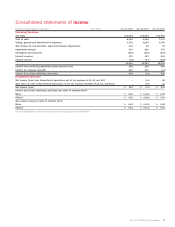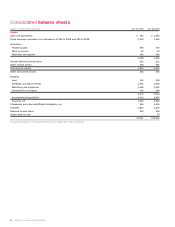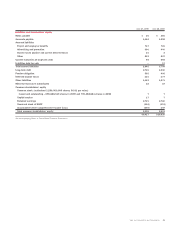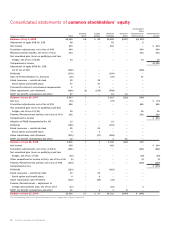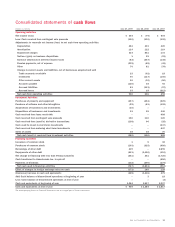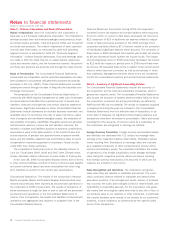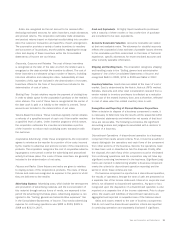Sara Lee 2009 Annual Report Download - page 45
Download and view the complete annual report
Please find page 45 of the 2009 Sara Lee annual report below. You can navigate through the pages in the report by either clicking on the pages listed below, or by using the keyword search tool below to find specific information within the annual report.ations involving the interpretation of complex income tax laws in
the context of our fact patterns. Any adjustment to a tax reserve
impacts the corporation’s tax expense in the period in which the
adjustment is made.
As a global commercial enterprise, the corporation’s tax rate from
period to period can be affected by many factors. The most significant
of these factors are changes in tax legislation, the corporation’s
global mix of earnings, the tax characteristics of the corporation’s
income, the timing and recognition of goodwill impairments, acquisi-
tions and dispositions, adjustments to the corporation’s reserves
related to uncertain tax positions, changes in valuation allowances,
and the portion of the income of foreign subsidiaries that is expected
to be remitted to the U.S. and be taxable. It is reasonably possible
that the following items can have a material impact on income tax
expense, net income and liquidity in future periods:
•The spin off of the Hanesbrands business that was completed
in 2007 has resulted in, and may continue to result in, an increase
in the corporation’s effective tax rate in future years as the opera-
tions that were spun off had, historically, a lower effective tax rate
than the remainder of the business and generated a significant
amount of operating cash flow. The elimination of this cash flow
has required the corporation to remit a greater portion of the future
foreign earnings to the U.S. than has historically been the case and
resulted in higher levels of tax expense and cash taxes paid. The
tax provision associated with the repatriation of foreign earnings for
fiscal years 2009, 2008, and 2007 was $58 million, $118 million,
and $194 million, respectively. However, a significant portion of the
corporation’s foreign earnings are permanently reinvested in its
foreign subsidiaries. In its determination of which foreign earnings
are permanently reinvested, the corporation considers numerous
factors, including the financial requirements of the U.S. parent
company, the financial requirements of its foreign subsidiaries, and
the tax consequences of remitting the foreign earnings to the U.S.
Variability in the corporation’s effective tax rate will occur over time
as a result of these and other factors which could materially change
the estimated cost of future repatriation actions.
•Tax legislation in the jurisdictions in which the corporation does
business may change in future periods. While such changes cannot
be predicted, if they occur, the impact on the corporation’s tax
assets and obligations will need to be measured and recognized
in the financial statements.
•The corporation has ongoing U.S. and foreign tax audits for various
tax periods. The U.S. federal tax years from 2005 onward remain
subject to audit. Fiscal years remaining open to examination in the
Netherlands include 2003 forward. Other foreign jurisdictions remain
open to audits ranging from 1999 forward. With few exceptions,
the corporation is no longer subject to state and local income tax
examinations by tax authorities for years before 2003. The tax
reserves for uncertain tax positions recorded in the financial state-
ments reflect the expected finalization of worldwide examinations.
The corporation regularly reviews its tax positions based on the
individual facts, circumstances, and technical merits of each tax
position. If the corporation determines it is more likely than not that
it is entitled to the economic benefits associated with a tax position,
it then considers the amounts and probabilities of the outcomes
that could be realized upon ultimate settlement with a taxing
authority, taking into consideration all available facts, circumstances,
and information. The corporation believes that it has sufficient
cash resources to fund the settlement of these audits.
As a result of audit resolutions, expirations of statutes of limita-
tions, and changes in estimate on tax contingencies in 2009 and
2008, the corporation recognized tax benefits of $16 million
and $96 million, respectively. However, audit outcomes and the
timing of audit settlements are subject to significant uncertainty.
The corporation estimates reserves for uncertain tax positions, but
is not able to control or predict the extent to which tax authorities
will examine specific periods, the outcome of examinations, or the
time period in which examinations will be conducted and finalized.
Favorable or unfavorable past audit experience in any particular tax
jurisdiction is not indicative of the outcome of future examinations
by those tax authorities. Based on the nature of uncertain tax
positions and the examination process, management is not able
to predict the potential outcome with respect to tax periods that have
not yet been examined or the impact of any potential reserve
adjustments on the corporation’s tax rate or net earnings trends. As
of the end of 2009, the corporation believes that it is reasonably
possible that the liability for unrecognized tax benefits will decrease by
approximately $100 million to $160 million over the next 12 months.
•Facts and circumstances may change that cause the corporation
to revise the conclusions on its ability to realize certain net operating
losses and other deferred tax attributes. The corporation regularly
reviews whether it will realize its deferred tax assets. Its review
consists of determining whether sufficient taxable income of the
appropriate character exists within the carryback and carryforward
period available under respective tax statutes. The corporation
considers all available evidence of recoverability when evaluating
its deferred tax assets; however, the corporation’s most sensitive
and critical factor in determining recoverability of deferred tax
assets is the existence of historical and projected profitability in a
particular jurisdiction. As a result, changes in actual and projected
results of the corporation’s various legal entities can create variability,
Sara Lee Corporation and Subsidiaries 43


